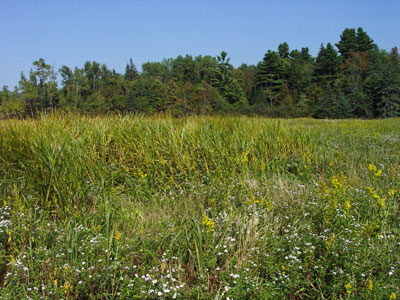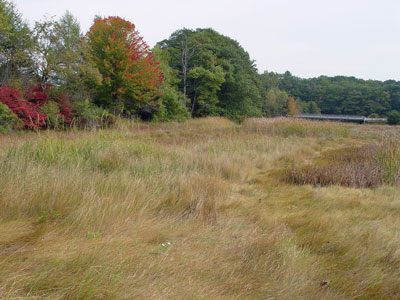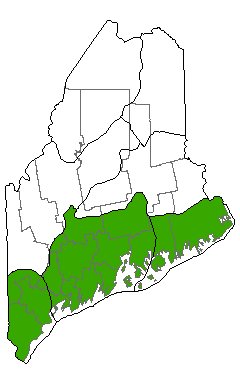DACF Home → Bureaus & Programs → Maine Natural Areas Program → Communities, Plants, and Animals → Natural Community Fact Sheets → Brackish Tidal Marsh
Printer Friendly Fact Sheet - 700 KB pdf (Get a free copy of Adobe Acrobat Reader)
Brackish Tidal Marsh
Scientific Name: Brackish Tidal Marsh; State Rank: S3

- Community Description
- Soil and Site Characteristics
- Diagnostics
- Similar Types
- Conservation, Wildlife and Management Considerations
- Distribution
- Characteristic Plants
- Associated Rare Plants
- Associated Rare Animals
- Examples on Conservation Lands You Can Visit
Community Description: Brackish tidal marshes contain both freshwater and brackish water species, often in bands corresponding to tidal exposure. Tall rushes and bulrushes often predominate over extensive mid-elevation flats. At the lower elevations, rosette-forming herbs, such as lilaeopsis and tidal arrowhead, may be common on the mudflats. Near the high tide line, there may be a fairly narrow zone of muddy gravel or rock shore sparsely vegetated with low herbs, including some rare species such as Long’s bitter-cress or water-pimpernel. Sweetgale and poison ivy are often present at the upper fringes of the marsh, at or above the tidal reach. Back to top.
Soil and Site Characteristics: These marshes occupy intertidal reaches in larger tidal estuaries where freshwater and saltwater mix. Salinity ranges from 2-18 ppt, with gradients reflected in the species composition of particular sites. The substrate is usually mud rather than peat. Back to top.

Diagnostics: These marshes occur in a brackish tidal setting. The vegetation is a mix of tall graminoids and rosette-forming forbs. Freshwater cordgrass, common arrow-grass, or wire-rush are present; obligate freshwater species, such as pickerelweed and common arrowhead, are absent. Back to top.
Similar Types: Freshwater Tidal Marshes are most similar and can grade into this type as one moves downriver; they usually feature wild rice and/or softstem bulrush as dominants, and contain species such as pickerelweed and common arrowhead that do not tolerate brackish water. Some marshes are intermediate in character between the two types. Mixed Saltmarshes and Salt-hay Saltmarshes develop a peat substrate and are dominated by obligate saltwater species such as saltmarsh cordgrasses, sea lavender, black-grass, or alkali bulrush. Back to top.
Conservation, Wildlife and Management Considerations: Tidal marshes are valuable wildlife habitat and have received considerable conservation attention. Many occur on or adjacent to public lands or private conservation lands (only a few of which are listed). With development of the uplands that border these marshes, maintenance of appropriate wetland buffers can help reduce degradation that could result from adjacent land uses. The prospect of sea level rise may also put these systems at greater risk.
Brackish marshes are important nesting habitat for several sparrows: Nelson's sharp-tailed sparrow and two uncommon species, the saltmarsh sharp-tailed sparrow and the seaside sparrow. These wetlands also provide foraging habitat for a large number of wading birds including rare species such as the great egret and glossy Ibis. The New England siltsnail inhabits coastal marshes and small tidal rivers where the water ranges from fresh to upper brackish. The spartina Borer Moth, whose historic range was along the immediate coast throughout New England, likely inhabited tidal marshes with sizeable populations of freshwater cordgrass, its larval host plant. Back to top.
Distribution: Coastwide, extending in both directions from Maine (Laurentian Mixed Forest and Eastern Broadleaf Forest Provinces). Landscape Pattern: Large Patch. Back to top.


Characteristic Plants: These plants are frequently found in this community type. Those with an asterisk are often diagnostic of this community.
- Sapling/shrub
- Sweetgale*
- Western poison-ivy*
- Herb
- Chaffy sedge*
- Chair-maker's rush*
- Common arrow-grass
- Freshwater cordgrass*
- Narrow-leaved cattail
- Northern blue flag
- Smooth cordgrass
- Softstem bulrush
- Wire rush*
- American oystercatcher
- Black-crowned night-heron
- Least bittern
- Saltmarsh sharp-tailed sparrow
- Short-eared owl
Examples on Conservation Lands You Can Visit
| Example | County |
|---|---|
| Acadia National Park | Hancock Co. |
| Hall Bay, Flying Point Preserve | Sagadahoc Co. |
| Mendall Wildlife Management Area | Waldo Co. |
| Morse Mountain Preserve | Sagadahoc Co. |
| Rachel Carson National Wildlife Refuge | York Co. |
| Scarborough Marsh Wildlife Management Area | Cumberland Co. |